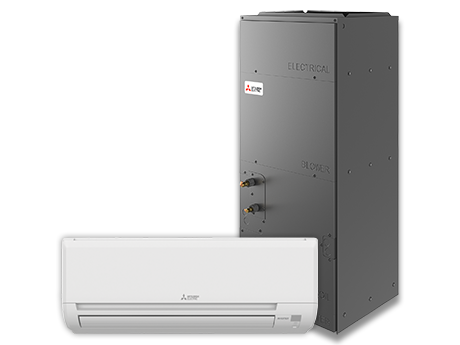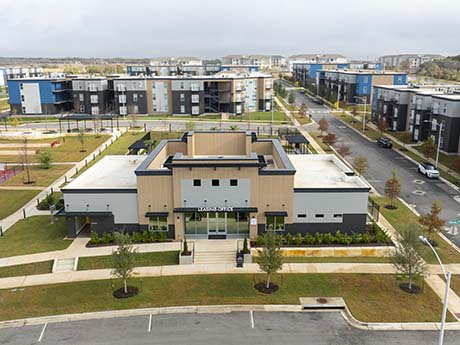By Randall Towb of Mitsubishi Electric Trane HVAC US (METUS)

METUS
Texas multifamily owners and developers are utilizing all-climate variable capacity heat pumps and variable refrigerant flow (VRF) systems for heating and air-conditioning (HVAC) needs in their low-rise, mid-rise and high-rise buildings. These systems deliver on both resident satisfaction and building owners’ return on investment (ROI) thanks to key benefits such as energy performance, zoned comfort, design flexibility, quiet operation, reduced maintenance and advanced controls and monitoring.
In addition to resident comfort and ROI, these all-electric systems align with growing concerns in Texas about water usage and grid resiliency — two key factors that city planners consider during the permitting process. This has builders taking note of the exceptional energy performance of all-climate heat pumps and VRF systems. Unlike conventional HVAC systems that operate on an all-or-nothing basis, all-climate heat pumps and VRF systems adjust the refrigerant flow to match the heating and cooling needs of individual spaces. The ability to modulate and precisely control energy use leads to reduced power consumption and overall building electrical capacity.

Below are examples of Central Texas multifamily projects utilizing different building types to showcase why these innovative systems are best suited for apartment building HVAC design and operation.
Low-Rise Communities
Three-story multifamily communities are one of the most abundant apartment building types throughout Texas. Z Modular, a fully integrated, self-development modular construction company, is helping to solve the housing crisis with a fast and efficient way to construct multifamily housing. Z Modular’s FLATZ communities offer more than 1,000 units across San Marcos, Marble Falls and Jarrell, Texas. All three of these communities have installed Mitsubishi Electric all-climate heat pump systems to create personalized comfort for residents. Specifically, Z Modular uses Mitsubishi Electric’s multi-zone ported MXZ-C outdoor units connected to ductless GS Premier Wall-mounted indoor units in each bedroom and living room.
This product combination provides personalized temperature control and comfort to each room in the apartment. Residents can also reduce energy usage in rooms that are not in use.
The typical two-bedroom Z Modular FLATZ apartment uses a 36 BTU/h size system (MXZ-4C36NA) which can require 25 amps of electrical capacity at the outdoor unit that feeds both the Mitsubishi Electric outdoor unit and the indoor units. The same 36 BTU/h conventional split HVAC system, with a 7.5 kilowatt electric heat kit, can require close to three times the amount of electrical capacity for each apartment.
The lower electrical capacity of the Mitsubishi Electric system may result in lower utility costs and several hundred thousand dollars’ worth of savings in construction costs to the developer by eliminating the extra 50-amp breaker and increased wire size inside each apartment.
The transformer and switchgear size reductions also make up a large part of the cost savings during construction and quickly offset the equipment costs of all-climate heat pumps over conventional HVAC split systems.
High-Rise Residential
High-rise multifamily buildings often use all-climate VRF systems, which allow for longer distances between the outdoor units and the indoor units. In downtown Austin, a new 49-story luxury residential tower on Rainey Street uses all-climate VRF technology from Mitsubishi Electric throughout 664 residential apartments, as well as in multiple common areas and mixed-use spaces on the lower floors.
VRF systems heat and cool different zones simultaneously by transferring thermal energy from the parts of the building that need cooling to the parts of the building that require heat. This energy transfer is referred to as heat recovery. In Texas, all-climate VRF systems have the ability to use less than 10 to 15 amps per apartment.
These systems allow for fewer roof penetrations, and they put less weight on the roof than hundreds of individual systems, giving building owners valuable rooftop space to use for other revenue-generating amenities.
Mitsubishi Electric’s all-climate VRF systems come equipped with advanced controls and monitoring capabilities. Building managers can monitor and adjust settings remotely, optimizing performance and enhancing the building’s response to peak energy demand. Predictive maintenance features can also alert to potential issues before they become costly problems, ensuring continuous comfort for residents.
In downtown San Antonio, a 17-story high-rise building on East Commerce Street is designed with all-climate VRF heat recovery technology throughout the 60 apartment units and a first-floor restaurant.
Both the Austin and San Antonio high-rise projects use ducted-style indoor units in each apartment. These ducted horizontal or vertical indoor units can be hidden to replicate the style of traditional, single-family home HVAC systems.
Mid-Rise Multifamily
Builders in urban infill spaces are utilizing the popular mid-rise multifamily building style to fit property space constraints. Modular and flexible all-climate heat pump and VRF systems are used to meet the differing needs of designers and operators. Many midrise developments use a combination of all-climate VRF in common areas and all-climate heat pumps for residential units.
In densely populated residential environments, noise reduction is crucial. All-climate heat pumps and VRF systems are designed to operate quietly, enhancing the overall living experience by minimizing the disturbance that can come from conventional HVAC systems.
Mitsubishi Electric’s all-climate heat pumps and VRF systems generally require less maintenance than traditional systems, predominantly due to their reliability and the quality of components. The modular nature of these all-climate HVAC systems means potential issues can often be isolated and repaired with minimal disruption and cost, enhancing their long-term operational viability. This can be particularly beneficial in apartment buildings where minimizing maintenance disruption is key to tenant satisfaction.
Ultimately, all-climate heat pump and VRF systems can be configured to meet the architectural intricacies and space constraints of any building, from high-rise towers to more sprawling, shorter building complexes. The systems offer significant advantages in terms of energy performance, personalized comfort, flexibility and sustainability. Their ability to meet the diverse needs of residents while reducing operational costs makes them well-suited for developers aiming to provide high-quality, comfortable living environments. In high-demand housing markets like those of Texas, all-climate heat pumps and VRF systems like those from Mitsubishi Electric are becoming increasingly popular.
This article was written in conjunction with Mitsubishi Electric Trane HVAC US (METUS), a content partner of Multifamily & Affordable Housing Business.
Learn more about METUS here.
For more information on becoming a Multifamily & Affordable Housing Business content partner, click here.


